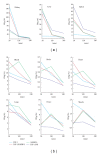Native and Complexed IGF-1: Biodistribution and Pharmacokinetics in Infantile Neuronal Ceroid Lipofuscinosis
- PMID: 22778966
- PMCID: PMC3384888
- DOI: 10.1155/2012/626417
Native and Complexed IGF-1: Biodistribution and Pharmacokinetics in Infantile Neuronal Ceroid Lipofuscinosis
Abstract
Infantile neuronal ceroid lipofuscinosis (INCL) is a severe neurodegenerative disorder of childhood characterized by selective death of cortical neurons. Insulin-like growth factor 1 (IGF-1) is important in embryonic development and is considered as a potential therapeutic agent for several disorders of peripheral and central nervous systems. In circulation IGF-1 is mainly bound to its carrier protein IGFBP-3. As a therapeutic agent IGF-1 has shown to be more active as free than complexed form. However, this may cause side effects during the prolonged treatment. In addition to IGFBP-3 the bioavailability of IGF-1 can be modulated by using mesoporous silicon nanoparticles (NPs) which are optimal carriers for sustained release of unstable peptide hormones like IGF-1. In this study we compared biodistribution, pharmacokinetics, and bioavailability of radiolabeled free IGF-1, IGF-1/IGFBP-3, and IGF-1/NP complexes in a Cln1-/- knockout mouse model. IGF-1/NP was mainly accumulated in liver and spleen in all studied time points, whereas minor and more constant amounts were measured in other organs compared to free IGF-1 or IGF-1/IGFBP-3. Also concentration of IGF-1/NP in blood was relatively high and stable during studied time points suggesting continuous release of IGF-1 from the particles.
Figures


Similar articles
-
CSF insulin-like growth factor-1 in infantile neuronal ceroid lipofuscinosis.Neurology. 2000 May 9;54(9):1828-32. doi: 10.1212/wnl.54.9.1828. Neurology. 2000. PMID: 10802792
-
The neuronal ceroid-lipofuscinoses.J Child Neurol. 1995 Nov;10(6):424-37. doi: 10.1177/088307389501000602. J Child Neurol. 1995. PMID: 8576551 Review.
-
A novel c.776_777insA mutation in CLN1 leads to infantile neuronal ceroid lipofuscinosis.J Child Neurol. 2013 Sep;28(9):1106-11. doi: 10.1177/0883073813494267. Epub 2013 Jul 14. J Child Neurol. 2013. PMID: 23857568
-
Free IGF-I, IGFBP-1, and the binary complex of IGFBP-1 and IGF-I are increased during human pregnancy.Horm Res. 2004;62(5):215-20. doi: 10.1159/000081246. Epub 2004 Oct 1. Horm Res. 2004. PMID: 15467298
-
Growth promoting peptides in diabetic and non-diabetic pregnancy: interactions with trophoblastic receptors and serum carrier proteins.J Pediatr Endocrinol Metab. 1996 Jan-Feb;9(1):21-9. doi: 10.1515/jpem.1996.9.1.21. J Pediatr Endocrinol Metab. 1996. PMID: 8887130
Cited by
-
Insulin-Like Growth Factors in the Pathogenesis of Neurological Diseases in Children.Int J Mol Sci. 2017 Sep 26;18(10):2056. doi: 10.3390/ijms18102056. Int J Mol Sci. 2017. PMID: 28954393 Free PMC article. Review.
-
Late-stage labeling of diverse peptides and proteins with iodine-125.J Pharm Anal. 2025 Jul;15(7):101198. doi: 10.1016/j.jpha.2025.101198. Epub 2025 Jan 17. J Pharm Anal. 2025. PMID: 40741338 Free PMC article. Review.
-
IGFBP2 Produces Rapid-Acting and Long-Lasting Effects in Rat Models of Posttraumatic Stress Disorder via a Novel Mechanism Associated with Structural Plasticity.Int J Neuropsychopharmacol. 2017 Jun 1;20(6):476-484. doi: 10.1093/ijnp/pyx007. Int J Neuropsychopharmacol. 2017. PMID: 28158790 Free PMC article.
References
-
- Santavuori P. Neuronal ceroid-lipofuscinoses in childhood. Brain and Development. 1988;10(2):80–83. - PubMed
-
- Vesa J, Hellsten E, Verkruyse LA, et al. Mutations in the palmitoyl protein thioesterase gene causing infantile neuronal ceroid lipofuscinosis. Nature. 1995;376(6541):584–587. - PubMed
-
- Riikonen R, Vanhanen SL, Tyynelä J, Santavuori P, Turpeinen U. CSF insulin-like growth factor-1 in infantile neuronal ceroid lipofuscinosis. Neurology. 2000;54(9):1828–1832. - PubMed
-
- Jalanko A, Vesa J, Manninen T, et al. Mice with Ppt1 Δex4 mutation replicate the INCL phenotype and show an inflammation-associated loss of interneurons. Neurobiology of Disease. 2005;18(1):226–241. - PubMed
LinkOut - more resources
Full Text Sources
Research Materials
Miscellaneous

